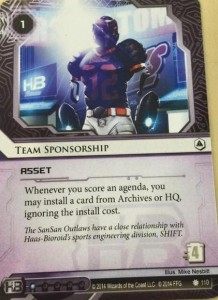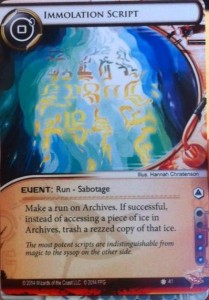Hello and welcome back to Deckspace, where we discuss offbeat Netrunner deck concepts. We’re back on the Corp side this week, and to celebrate the imminent release of The Source (the datapack, not the card) we’ll be discussing a HB identity that is considered to be one of the weakest IDs in the game: Stronger Together.
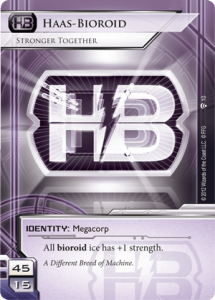
The best identity in the game for making your opponent’s eyebrow raise when you slap it down on the table.
Why is The Source so important to Stronger Together? Because it marks the release of the best Bioroid ICE released since Eli 1.0, all the way back since the Genesis Cycle: Markus 1.0.
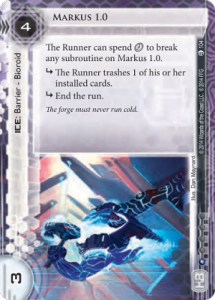
In the mix with Markus Schulz.
Stronger Together obviously gets better the more Bioroid ICE is released, and Pre-Markus, the options for appropriate Bioroid ICE are remarkably few. They are the following:
Useful ICE, loosely ordered from best to worst:
- Eli 1.0 (The King)
- Viktor 1.0 (Hates Yog)
- Ichi 1.0 (Does nothing without installed programs)
- Viktor 2.0 (Costly and not actually punishing to facecheck)
Marginal ICE, again loosely ordered from best to worst:
- Sherlock 1.0 (Very costly and often does nothing. May actually help Noise.)
- Hudson 1.0 (Cheap and high-str, but does nothing to help you in most cases)
- Zed 1.0 (Cheap but low-str, and usually does nothing)
Big ICE, again loosely ordered from best to worst:
- Heimdall 1.0 (The HB Tollbooth, except a desperate Runner can get through for 2 clicks)
- Ichi 2.0 (Not usually worth 3 credits more than Ichi 1.0)
- Heimdall 2.0 (As Heimdall 1.0, but now you’re paying 3 more)
- Janus 1.0 (Fifteen to Rez)
One issue of Stronger Together is that its identity ability is often irrelevant. Janus 1.0 does not get significantly scarier when its strength becomes 9 instead of 8. Likewise, your str-8 Heimdall 2.0 can still be clicked through at the cost of a Brain Damage and half a turn, negating both your 11 credit investment and your identity. We can see that what Stronger Together really wants is to stack multiple cheap Bioroids on a server, forcing the Runner to break them and thus pay the Stronger Together Tax. Eli 1.0 is obviously the best at this, but sadly we are not allowed to run eighteen copies of Eli 1.0.
The other issue of Stronger Together is that it is competing with one of the strongest identities in the game: Engineering the Future. It’s a common critique that most Stronger Together decks could be improved by just swapping the identity to EtF. And indeed this is often true; you’ll often find yourself wishing you had a few more credits as you struggle to rez your ICE, which runners either click through or bounce off anyways.
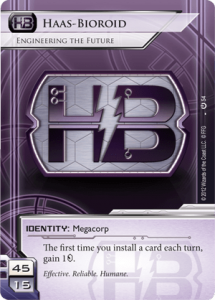
Wouldn’t you like to get 10+ credits over the course of the game? You install things, right?
The fantasy with Stronger Together is that the Runner will put out a Gordian Blade, a Corroder and a Garrote, and then proceed to pay 2 credits extra whenever they run one of your centrals for the rest of the game. Here’s a dirty secret: this is not how Netrunner is actually played. Your ICE will be clicked through, Parasited to death, Yogged, Femmed, Atmanned, Inside Jobbed, Emergency Shutdowned, Knighted, D4v1ded and so on. Good Runners will not pay the Stronger Together Tax over and over to access a single random card from R&D; they’re a clever bunch, and so they’ll find clever ways to make your identity irrelevant however they can.
That’s enough talk; let’s see a decklist:
The Decklist
Haas-Bioroid Stronger Together
15 influence spent (max 15) •••••••••••••••
20 agenda points (between 20 and 21)
49 cards (min 45)
Cards up to The Source
Agenda (11)
3x Accelerated Beta Test
1x Director Haas’ Pet Project
1x Gila Hands Arcology
3x NAPD Contract
3x Project Vitruvius
Asset (9)
3x Jackson Howard •••
3x PAD Campaign
3x Private Contracts
Upgrade (3)
3x SanSan City Grid ••••• ••••
Operation (8)
1x Archived Memories
3x Blue Level Clearance
3x Hedge Fund
1x Subliminal Messaging
Barrier (6)
3x Eli 1.0
3x Markus 1.0
Code Gate (9)
3x Pop-up Window •••
3x Viktor 1.0
3x Viktor 2.0
Sentry (3)
3x Ichi 1.0
http://netrunnerdb.com/en/decklist/12215/stronger-together-fast-advance
Why yes, that is 15 points of NBN influence we’re using. The breakthrough card here is really SanSan City Grid; the deck cannot work without it. This is one of the strengths of HB; since it is the most well-rounded faction, it does not need to spend influence for anything in particular (unlike Weyland’s lack of Code Gates) and thus can afford to spend the lion’s share of its influence on something fancy, such as a fast-advance package.
Playing the Deck
You have absolutely no hard End-The-Run subroutines on any of your ICE, so your centrals are always extremely porous: if the runner wants to get in (for, say, Account Siphon) they probably can. Trying to make a server impenetrable using only Bioroids is an exercise in futility, so instead you want to make your centrals moderately taxing while distracting the Runner with a constant stream of annoying “Must-Run” economy assets. Since all your agendas required 3-advancement, any unrezzed card in a remote threatens to be a 2-pointer and thus demands a run. If the Runner seems to ignore all your unrezzed remotes, install a naked Agenda and score it the following turn to punish them.
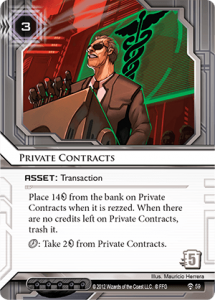
I just got put down behind an ICE. Am I an Accelerated Beta Test? You have to check at least sometimes, or I’ll start always being an Accelerated Beta Test!
Mulligan decisions are fairly standard; you want economy and ICE, with as few Agendas as possible. Any 3+ Agenda hand should be tossed, and a 2 Agenda hand should be given a very hard look; I would probably not keep it unless the other three cards were Hedge Fund and two good early-game Bioroids (eg: not Ichi 1.0).
Your first goal is to secure centrals; even if you don’t expect Archives pressure, slapping one ICE on Archives is a good idea anyways since you’ll be tossing away agendas with Jackson. PAD Campaigns should be installed ASAP; installing them naked is fine. If you think the Runner will trash your assets aggressively, install them one at a time behind a small Bioroid.
Whereas most Corps would like to score Agendas in the midgame, you have no such ability; your Bioroids will never be impassable. Your goal in the midgame is to leverage your economy assets into a large surplus of credits. Private Contracts is the main way to do this; once you feel your servers are mostly secure, Rez it and use it three times. This gives you 3 credits, just like clicking for a turn, but now there is a must-trash asset on the field, and if the Runner does not respond (or cannot respond) then you can take the remainder of the credits at your leisure, getting you the money you need to Fast Advance agendas.
Your “scoring” remote does not need to be heavily ICEd; at first it will be something like Eli 1.0 protecting a Private Contracts. Once you fully deplete the Private Contracts, put a SanSan in there. If they run it, it’s a massive win for you, trash or no. If they don’t run it, try to engineer a situation where you can Fast Advance an Accelerated Beta Test (the HB Astroscript) with a Jackson Howard on the field (possibly in your lightly ICEd “economy-remote”). 8 credits will get you 2 points, as well as a Rezzed SanSan which basically says “Trash me now or lose”. If you find ICE with the Beta Test, ICE the SanSan further. Should they fail to trash the SanSan, you can score one Agenda a turn for two credits until they do.
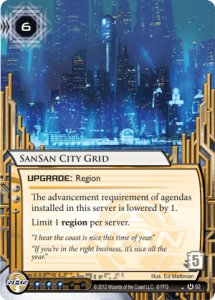
Much like Jackson Howard, this card enables many plays, all of which are good for you.
Continue this economic warfare until you can stick a SanSan and score four agendas. You have the Never-Advance playstyle at your disposal, enabling risk-free bluffs of installing Howards into your scoring server to induce a costly, useless run. Should the Runner break himself, you can leverage that into an agenda score by installing two agendas behind Bioroids, ensuring that only one of them will be run. Alternatively, install and single-advance an NAPD Contract if you don’t think they can muster up the four credits to steal it.
If this playstyle sounds familiar, that’s because this is basically the Near-Earth Hub Fast Advance playstyle. Taxing, porous ICE; taxing economy assets; SanSan play to create no-win scenarios for the Runner. It’s the Stronger Together take on HB Fast Advance, and it works.
Beating the Deck
Given our porous ICE, the deck is quite vulnerable to Account Siphon, although we can fight it naturally by rezzing costly assets. Runners that pound centrals with multi-access (The Maker’s Eye, Medium, etc) are hard to deal with, as stacking ICE on R&D gets prohibitive rather quickly.
Cards that hate on asset-economy (Whizzard, Paricia, Imp) will make the taxing plan less potent. Cards that hate on Fast Advance (The Source, the upcoming Clot) will make it difficult to score points.
Atman is this deck’s nemesis, as all your ICE is either Str-4, Str-5 or Str-6. Atman on 4 with Datasucker support hurts you so much you may consider bringing in Swordsman if it’s running rampant in your meta.
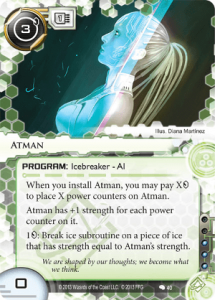
The Stronger Together Tax: Making them put one more power counter on Atman.
Half your ICE is Code Gates, so Yogasaurus can invalidate a lot of your defenses in a hurry, especially against a Kit wielding a Paintbrush. Thankfully, Yog only negates about a third of Pop-up Window’s value.
Being an all Bioroid deck means E3 hurts us, but since all our Bioroids are small it isn’t completely devastating. Breaking Eli 1.0 for 1 click and 1 credit is not all that different than breaking it for 2 clicks.
Card-by-Card Analysis
Agendas
- Accelerated Beta Test is the HB Astroscript, in the sense that a successful Beta Test will get you about 7 creds worth of value. It’s obviously a risky proposition and it’s not always viable, but if you can set it up with an active Jackson you can get very far ahead using it.
- Director Haas’ Pet Project brings back dead SanSans, dead Howards, dead Private Contracts and any ICE you may have trashed or NoiseMilled. You can also install from your hand in a pinch.
- Gila Hands Arcology is unassuming, but very helpful. Scoring it early gives you a permanent Private Contracts-esque effect: fully unloading Private Contracts will take 7 clicks over three turns and give you a profit of 4 credits; using Gila Hands three times over three turns will put you up 3 credits.
- NAPD Contract is solid filler for the taxing plan, and can be scored in a pinch. You can be cheeky by tossing it into Archives and not Jacksoning it back if the Runner can’t afford it.
- Project Vitruvius is a blank 3/2, much like Project Beale often is for NBN. Still, we like 3/2s here.
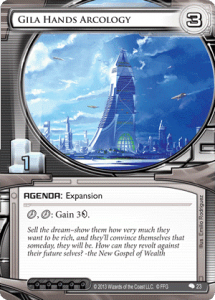
Never underestimate the value of a scored Gila Hands.
Assets
- Jackson Howard is Jackson Howard. It has additional value here by getting back trashed SanSans, ensuring you are never without a way to win.
- PAD Campaign is the gold standard for taxing Asset economy. Protect these only after Rezzing, and only if you think the Runner will go after it.
- Private Contracts is like a heavy-duty Melange; fewer credits overall, but 5 to trash is no joke.
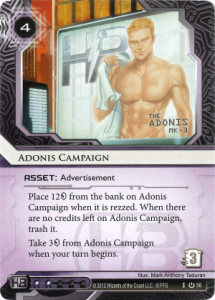
Why aren’t you running me? I’m a good card! I’ll get you 8 credits!
Upgrade
- SanSan City Grid is the lynchpin of this deck, due in no small part to its cost to trash. Forcing the Runner to trash an unrezzed SanSan is a colossal win.
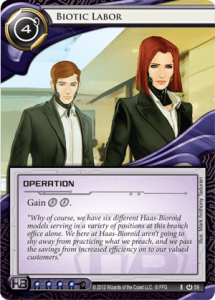
I hear you, Adonis. I think he forgot about us.
Operations
- Archived Memories is a nice, versatile card; in the midgame, it effectively acts as a tutor, getting you your choice of ICE (that died to Parasite), economy (get back that Private Contracts) or a dead SanSan. If you have nothing better to do, you can spend your turn getting back a Blue Level Clearance and playing it. If you are willing to lose some flexibility for potentially higher value, Reclamation Order is an option given all our 3-ofs. Reclamation Order on 3 Hedge Funds feels dirty.
- Blue Level Clearance packs a lot of value into a single card. Playing it is like getting a Beanstalk Royalties followed by a Jackson click. Given that we want to draw into lots of our taxing economy assets, this is a fine choice. You might feel tempted to swap this out for Green Level Clearance, which is stronger on turn 1 but does little for you after that. GLC helps your turn 1 and thins your deck after that; BLC gives you “five” for your two clicks, allowing you to reload efficiently.
- Hedge Fund is a good card. Never cut it.
- Subliminal Messaging can net you a free credit here and there; it’s good value if you can recur it even once, and everything after that is nuts. This basically says “Run now and pay the Tax, or skip the Tax by not running and I’ll get free money.”
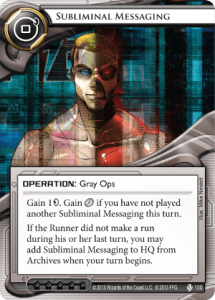
Pressure the Runner enough and they’ll eventually crack.
ICE
- Eli 1.0 is the best ICE in the deck. Play it, love it.
- Markus 1.0 is a worse Eli 1.0; 1 less strength, 1 more to Rez. Its first subroutine might seem powerful, but it’s far weaker than the almighty “Trash 1 program”. For starters, it doesn’t end the run, so it’ll do nothing to stop the Runner on critical runs. The Runner chooses what to trash, so it’s very easy for them to find a card they don’t really need anymore; a depleted Cache, Daily Casts or Armitage Codebusting; a redundant Datasucker, a dead Dog. Markus is like an Eli that says “well, if it’s not convenient for you right now to spend two clicks, I’d be happy with just one click and whichever installed card you don’t need anymore.” Despite all that, it’s a Bioroid with a reasonable Rez cost and widely applicable subroutines, so we want three.
- Viktor 1.0 is a Bioroid that ends the run.
- So is Viktor 2.0, except it costs 2 more but doesn’t allow the Runner to just tank the Brain Damage.
- Ichi 1.0 is often dead on turn 1, but its existence forces the Runner to respect your unrezzed ICE. Note that you don’t really care about the Trace, since most widely played Runners have 1 link and you never want to Vamp yourself trying to tag the Runner. Save your credits for SanSan.
- Pop-up Window is not as critical to the deck as the previous 15 pieces of ICE; these last three slots and three influence are your flex slots. I like Pop-up Window here because this deck usually dies if it fails to find enough ICE or enough economy; this is a card that gives you both, even if you’re on zero credits.
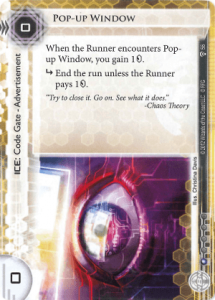
I will never let you down. Except if you install me on HQ and get Account Siphoned, then I’ll totally screw you over.
Future Cards
At the time of writing there are no spoiled future Bioroids, which is what this deck really wants more of. Any non-HB cards would be competing with Pop-Up Window, which is very stiff competition; however there is one HB card that might be worth a second look:
It’s a situational effect, but as a taxing asset it could be worth playing. At four to trash you want the Runner to waste their time trashing this, and you’re obviously never Rezzing it until you’re ready to get value from it, getting an Interns effect every time you score an agenda (granted, which is not that often).
The one card that will most definitely affect this deck, however, is this one:
Given your ICE composition, ICE-trashing decks will have a fun time burning Eli 1.0 alive with this card. There’s not a whole lot that can be done, other than making Archives taxing to run and gritting your teeth.
Roads not Taken
- Big ICE and Bioroid Efficiency Research: this is a different deck, and one that would be better served by a different Identity. Janus is not helped by being Strength-9. Play it in EtF.
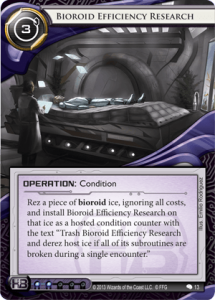
See, the thing that’s keeping Wotan back is its meager Strength of 10. On the other hand, if it was one higher…
- I played Zed 1.0 once. It simply doesn’t do very much. You need to install it on the inside of a server first (I hope that server isn’t important, because Zed 1.0 does nothing to protect it alone). Then you need to install another Bioroid on top. And then the Runner needs to click through the first Bioroid, and if they can’t break through a Str-2 Sentry, they’ll take brain damage. Nevermind the fact that Ichi 1.0 would be infinitely more damaging in this case; the Runner needs to facecheck an unknown ICE, with no Killer, on their last click, against Stronger Together.
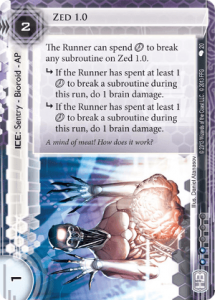
Note that Zed 1.0 is apparently worth 2 influence.
- I also played Hudson 1.0; more than once, even. It does nothing to protect Archives unless you have 2+ agendas in there, at which points it only allows the Runner to steal one of them (they get to flip all unknown cards up before choosing which to access). It does nothing to protect R&D on its own and won’t help you against an Indexing, although it makes Medium and R&D Interface worse. It does nothing to protect HQ against repeated accesses or Account Siphon, although it will make Legwork harder to pull off. It does nothing to protect your remotes, unless you have an installed Upgrade at which point the Runner must make two runs, if he wants both. Sorry Hudson 1.0, you suck.
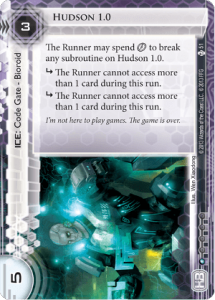
Hudson is exactly what this deck needs: more Code Gates.
- Sherlock 1.0: I wanted this guy to be good; two subs, high strength, Sentry (taxing to break). But it really isn’t. 6 to Rez is a lot for something that doesn’t end the run or even slow down a Runner that doesn’t have programs. It can randomly get hosed by Link (The Toolbox, Underworld Contacts). Noise can abuse it to reinstall Cache over and over. And “Time Ebb a program” is very, very different from “Trash a program”. One can be devastating to a deck without redundancy. The other is a mild annoyance, having to draw and re-install Corroder.
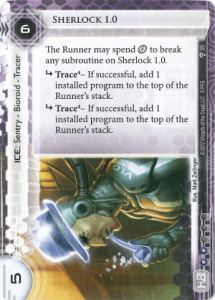
Choose your doom, Andromeda: Pay 2 clicks, pay 6 credits to dodge Traces, or face the pain of having to re-install that Faerie!
- Adonis Campaign and others: the dirty secret is that we’re not actually planning to use our assets to get money. We’re using them as distractions so that the Runner doesn’t hammer our centrals every turn. As such, we evaluate assets from a “Worst-Case” perspective. In the worst-case, Adonis will be installed (naked, appropriately), Rezzed for a net cost of 1 and then trashed for 3. PAD is the same but is 4 to trash. By that logic, we run PAD instead of Adonis. This also applies to Eve and Rex.
- Melange Mining Corp: we really want its effect, but 1 to trash is really soft in centrals. It’s also deeply unlikely you’ll get to use it more than once, so we run Private Contracts instead.
- Biotic Labor: Biotic Labor lets you score an Agenda from hand using 7 credits. SanSan will let you do the same for 8 credits (and an install). However, SanSan leaves behind a massive “trash-me-or-lose” target. When you play Biotics, you’re taxing yourself; when you plan SanSans, you’re taxing the Runner.
- Operation economy: The first iteration of this deck played Restructures and Medical Research Fundraiser. These are fine cards, but they let the Runner focus on Centrals exclusively. You also put very little pressure on the Runner by simply playing Restructure after Restructure, allowing them to rig up or Run as is convenient for them.
- The three flex slots: there are a number of good options, with 3 Pop-ups being solid in all cases. If you’re mortally afraid of Account Siphon, you could play Sealed Vaults. Executive Boot Camp and Daily Business Show are both solid taxing assets. You could play the miser’s Rototurret, a single Heimdall 1.0 and then The Root. You could play the PAD Campaign from Hell, Marked Accounts. You could play some blend of Mental Health Clinic, Sweeps Week, Interns, More Subliminal Messagings, Green Level Clearance, Reversed Accounts, Targeted Marketing, Psychic Field, Crisium Grid, Fast Track, Restructure, Mother Goddess, Closed Accounts, Lotus Field, Pup, Tollbooth, Swordsman…
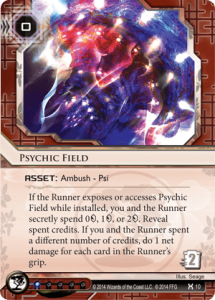
Yes, this card is actually just 1 influence. Are you surprised? I was surprised. The Runner will be surprised, too.
- Heinlein Grid: I initially set out to make this card good, playing three copies. Sadly, this just doesn’t do enough to justify its inclusion. The fantasy is that they’ll face-check Ichi 1.0 without a Killer and be faced with “Lose all your credits or Lose 2 programs”. The reality is that that doesn’t happen all that often. With Viktor, you don’t care enough about the Brain Damage to spend three credits. Your money is stretched to the maximum between paying for ICE and paying for SanSan; you simply cannot spare three credits to durdle around with a pseudo-trap.
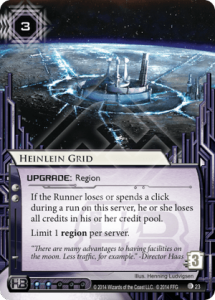
I’m sorry, Heinlein Grid. I really thought you were going to the card that put Stronger Together on the map, but it turns out that card is in NBN.
Why you should try this deck
Maybe you want to win a game with Stronger Together. Maybe you want make the best piece of ICE in the game even better. Maybe you want to constantly have to correct the Runner’s Math: “No, it’s strength FIVE.”
That’s it for Stronger Together; join me next week as we build one last Anarch deck before Order & Chaos changes the face of Anarch forever. Feedback is, as always, highly appreciated. If you have any suggestions for deck archetypes you’d like to see me discuss, email me at Nagnazul@gmail.com.
Until next time, keep on running, and keep on spending three clicks to check out the smiling face of Jackson Howard.





